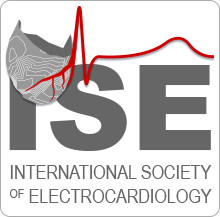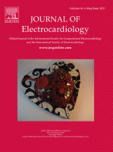Dear Goksel,
I am very pleased and honoured to be able to review my participation in the International Congress of Electrocardiology through the years. To do so, I have to step back a little in time before the International Society of Electrocardiology was formed.
Background
In 1959, a group of cardiologists with a specific interest in electrocardiography met in Wroclaw, Poland and they organised what was called the Colloquium Vectorcardiographicum which first met in 1960. [Please see the time lines on the Young Community website.] They met annually thereafter in Eastern Europe but I became aware of their activities when they first met in Western Europe, in Vienna, in 1967. This was the first meeting of the group which I attended. On that occasion, I always remember meeting Dr Ron Selvester and his wife Jean, who took this new boy (me!) under their wing! Ron was of course very well known even at that time. Half the papers at the meeting were presented in German and half were presented in English and so I returned home and went to night school for one year to learn the basics of the German language because I thought that if I had to attend the conference every year, it would be much better if I understood more than 50% of the presentations. As it happened, all meetings thereafter used the English language!
My next ECG, or should it be VCG, conference was in Jablonna, on the outskirts of Warsaw in 1969, and that was my first experience of travelling to Eastern Europe about 8 years after the Berlin wall was built. There were perhaps 30 people meeting in a hotel on the outskirts of Warsaw and I was invited to stay on afterwards to tour in the south of Poland (Katowice). Somehow or other I managed to change my flight home, which was rather difficult at that time. During that visit, I managed to visit Auschwitz and nervously allowed myself to be interviewed by a TV company filming the site. The following year, the meeting was held in New York as part of a symposium on vectorcardiography and was well attended.
In 1971, a 6 day meeting of single sessions was held in Brussels, with Pierre Rijlant as the organiser. He had been President of the World Congress of Cardiology in Brussels in 1967 and had a major interest in electrocardiography. In 1972, the meeting was held in Dresden and that was another adventure which involved travelling via the divided city of Berlin in order to cross to the Eastern sector, and then take a train to Dresden. There were no guide books that I could find at the time! In 1973, the meeting was in Yerevan, Armenia in the shadow of Mount Ararat. Travel was via London and Moscow. For me, this was the start of regular visits to Eastern Europe every second year, with meetings taking place in Western Europe in the intermediate years.
International Congress of Electrocardiology
In 1973 in Yerevan, Armenia, it was proposed that the name of the meeting should be changed to the International Congress of Electrocardiology and in 1974 in Wiesbaden, Western Germany, the first meeting with this title was held.
At the Wiesbaden meeting, all the greats of electrocardiology of that era attended. They included Ernst Simonson, whose book on the normal ECG published in 1961 was an absolute classic at the time. Hubert Pipberger, who was in the forefront of developing automated ECG interpretation using XYZ leads, was present as was Otto Schmitt if I recollect correctly. He was the inventor of the Schmitt trigger and also an orthogonal lead system.
These meetings up until that point alternating between east and west had been a great experience in terms of understanding a different part of the world under a different type of rule at that time. Travel could be nerve wracking and there are many stories that could be told but space does not permit. The meetings continued in east and west and in 1983, a decision was made to form the International Council on Electrocardiology. Professor Ivan Ruttkay-Nedecky from Bratislava was appointed the first President of the Council.
The meetings continued to alternate between east and west until shortly after the Berlin Wall came down in late 1989, soon after the meeting in Budapest into which many people had escaped from East Germany. I went for a jog one day and was surprised to note many TV cameras en route. They were actually pitched outside a refugee camp and were not there to capture me jogging! After the wall came down, travel between east and west then gradually became easier.
Finally, in 1993, the International Society of Electrocardiology was formed in Kananaskis, Alberta, Canada. The President of the Council and first President of the Society was Professor Fernando de Padua from Lisbon.
So the most special aspect of the Society in the early years was the continued link between East and West Europe, with the added participation of experts from the rest of the world. There was also a tremendous social aspect to the meeting with, on occasions, up to 30 spouses participating in a separate Ladies Programme. This is perhaps one of the big disappointments of the current era in that the accompanying persons programme has diminished somewhat. I placed great emphasis on this programme for the ICE meeting in Glasgow in 2013 with a visit to the world famous Edinburgh Military Tattoo at Edinburgh Castle, Stirling Castle, plus a choice of distilleries to visit, etc! Accompanying persons had their own social programme at other times.
Does electrocardiography still have a role to play?
You have asked if Electrocardiography is not as important compared to what it was. I think it is. There have been significant advances in the field in the last 25 years which have influenced clinical practice. No one ever used the term STEMI before 2002 and even ECG abnormalities such as the Brugada Pattern were not acknowledged until the 1990s. Consensus papers on the definition of early repolarization first emerged in 2015. Inverse modelling of cardiac activation was incorporated into a commercial product relatively recently. Of course, Echocardiography and Magnetic Resonance Imaging (MRI) are complementary to electrocardiography and provide different information compared to the ECG. However, many cardiac arrhythmias are certainly not reported easily with these techniques, if at all, and there is still a clear role for the ECG in many areas of medicine, given its simplicity and ease of recording and a unique ability to detect conduction defects, arrhythmias like ventricular tachycardia and so on.
Large databases are now being used with Artificial Intelligence techniques to use the ECG in a diagnostic and predictive mode, although I remain to be convinced that the specificity of the techniques will prove acceptable. Single channel ECG recording has taken off dramatically and the use of automated methods for analysis has allowed this approach to flourish, although there are limitations with the use of one lead. All in all, electrocardiography is far from being dead!
The Future
The future is difficult to predict. I have heard frequently through the years that Body Surface Mapping would replace 12 lead Electrocardiography and while there are now fantastic facilities utilising multiple electrodes in conjunction with advanced modelling, the simplicity of the 12 lead ECG remains. There is still a lack of an internationally accepted database of a large number of ECGs for assessment of automated rhythm analysis although steps are being taken to change this shortcoming. There are differences in the normal limits of the ECG in different races and to some extent, current automated methods of interpretation only scratch the surface in this area. Much remains to be done in that respect. There are gender differences in ECG limits of normality and again, more requires to be done to enhance sex dependent diagnostic criteria.
There are huge areas of the world where ECG recording has still to be implemented widely in order to influence health care. This will take years of effort if money can be found.
One point which concerns me is that if a large percentage of the population feel it is necessary to wear some form of cardiac monitor 24/7, even in the form of a wristwatch, who is going to check the thousands, or will it be millions, of sample tracings which will be sent to the cloud, for example, many with resultant interpretations which will be false positive?
It is pleasing to note that there is now a young persons’ section of ISE, the Young Community. For years, there has been a Young Investigator’s Competition at the annual ICE. More recently, the Bayes Award has been established to reward one young investigator annually for excellence in research as evidenced by publications. Thus, the formation of the Young Community is a very welcome development in the history of ISE. Hopefully, social media, the enhanced ISE website and webinars will lead to many cardiologists in training and beyond joining the Young Community, and in turn advancing the science of electrocardiology. Thanks are due to a few individuals on the ISE Council for establishing the newer awards, webinars, and upgrading the website.
The sceptics may say that electrocardiography is not a fashionable area for research. However, I have been involved in the field for over 50 years and see no reason why electrocardiography, indeed electrocardiology, should suddenly cease to be of any value! Of course there are many branches of the topic that are now available to be exploited in terms of research, so I wish all members of the Young Community every success in their future work.
Let’s hope for some resolution of the Covid pandemic in 2021 and a return to ISE meetings, certainly by 2022, which can be attended in person by all enthusiastic electrocardiologists

